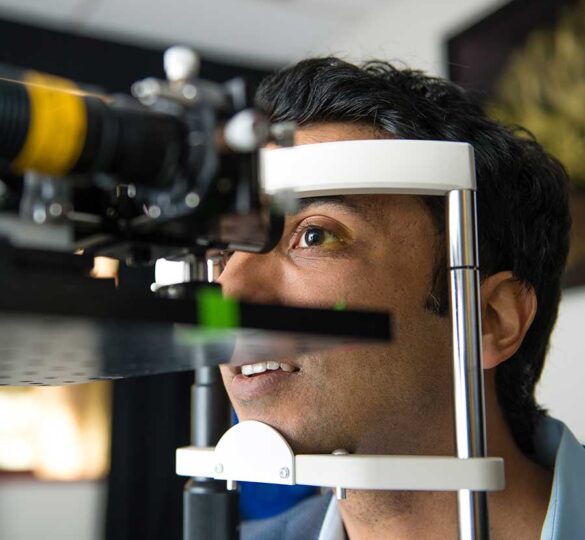2018 Glaucoma Research Update: Vivek Srinivasan’s Laboratory

The Srinivasan Laboratory at the University of California, Davis, develops novel optical imaging techniques and diagnostics with applications spanning from basic to clinical research.
Vivek Srinivasn, PhD is a principal investigator in the Catalyst for a Cure Biomarkers Team funded by Glaucoma Research Foundation in San Francisco, CA.
Catalyst for a Cure brings together scientists from different backgrounds to work collaboratively to understand glaucoma and find ways to improve treatment and ultimately cure this blinding disease.
The Srinivasan Laboratory at the University of California, Davis, develops novel optical imaging techniques and diagnostics with applications spanning from basic to clinical research.
Their highly interdisciplinary approach combines cutting edge imaging technologies with collaborations ranging from neurobiology to neurology and ophthalmology to test fundamental hypotheses and explore the diagnostic implications.
Watch the video for a research update from the Srinivasan Lab at UC Davis.
Video Transcript
Dr. Srinivasan: Over the past five years we’ve put a lot of work, the whole team, into learning the basic science of glaucoma, into really finding out what are the earliest changes in the disease. We built instrumentation to detect those changes early, and tested them in human subjects.
I think the most important, impactful moment for me was when we actually took one of the instruments we built and put it in the ophthalmology clinic. When the first patient came in and sat down, it really hit me how all of that work was really coming to fruition and that we were finally going to use some of this knowledge to help benefit patients.
Well, one specific event that my lab has contributed to the ‘Catalyst for a Cure’ is we’ve developed high-resolution imaging methods that we can look into the eye and take very high-resolution photographs of layers in the retina that are affected early in disease. And over the past year we’ve been able to do that with much higher resolution. We’ve been starting to see details that we couldn’t see before. We’re very excited that we’re now finally getting to look at some of these early changes in glaucoma patients.
We’ve developed new imaging technologies for the retina based on scanning a low-power laser beam on the eye. It’s very similar to a retinal scan that you might see in the movies — instead of opening a door, we use the retinal scan to take very high-resolution pictures of the eye. We’ve made great strides, both myself and Alfredo Dubra, in improving the resolution of those pictures to the point where we can now see individual ganglion cells and individual neurites, connections between the cells.
One of the results of this collaboration is that we were able to take a basic science finding from Andrew Huberman’s lab that certain layers in the retina are affected early in glaucoma — and we’re immediately able to develop engineering approaches to see some of those changes in human patients with glaucoma.
This would not have been possible otherwise because usually the basic science labs don’t talk to the engineering labs and physics labs, which don’t necessarily always have connections with clinical ophthalmology. In this collaboration, we’ve been able to take a finding and advance it very quickly to the point where it can be used to help diagnose glaucoma.
Well, if it wasn’t for ‘Catalyst for a Cure’ at a personal level, I think I wouldn’t have had these opportunities that I have. ‘Catalyst for a Cure’ has given me both the collaborators, the support to take some of our ideas and really advance them to the point where they’re helping patients and having a real impact in glaucoma. I think that’s a very unique aspect of the ‘Catalyst for a Cure’. Most granting agencies, federal agencies, don’t necessarily support this type of collaborative research, and I think ‘Catalyst for a Cure’ is a very unique opportunity for us to do that.
I’d like to say this has been a great opportunity for me as a scientist. I’ve greatly enjoyed working with the other three ‘Catalyst for a Cure’ scientists. I’ve learned a lot from them. I think some of the connections that I’ve made and the early results that we have, I’m looking forward to over the next 5-10 years to seeing those through to fruition.
We’re talking with ophthalmic instrumentation companies, and we’re sharing our early results with them. It’s a hope that with some of the results coming out over the next year, in the next few years, that they’ll see this as a real opportunity to make these tools more widespread and more widely used, so that they can help detect and diagnose glaucoma all over the world.
First posted on February 22, 2018; Reviewed on May 18, 2022